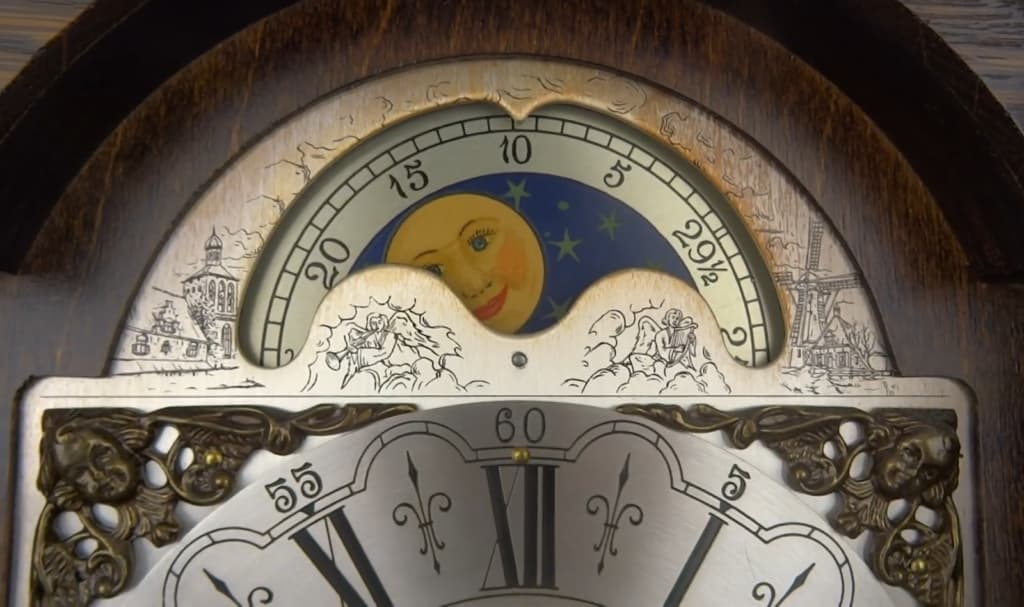A majority of grandfather clocks equipped with mechanical movements typically feature a fully operational astrological moon dial. The design spectrum for these moon dials ranges from minimalist depictions to intricate and highly detailed renditions.
How Does a Moon Dial Work?
Have you ever wondered how a moon dial works its celestial magic within a grandfather clock? Delve into the intriguing world of lunar timekeeping as we unravel the inner workings of these captivating mechanisms.
At the heart of the moon dial’s enchantment lies its slow, rhythmic motion, which faithfully follows the 29.5-day lunar cycle. Within the moon dial, an image of the moon gracefully moves, not only indicating the lunar date but also portraying the moon’s position in the night sky. For instance, when the moon’s image vanishes, it signifies the arrival of the new moon phase. Conversely, the moon image reappears at the top of the dial on the 15th day, beautifully mirroring the lunar journey.
What’s truly remarkable is that the moon dial seamlessly synchronizes with the clock movement. Once initially set, it requires no further adjustments, elegantly enhancing the allure and functionality of these timeless timepieces. Join us as we embark on a celestial exploration to demystify the enigmatic workings of moon dials, shedding light on their historical significance and enduring charm.
How to Set Grandfather Clock Moon Dial?
Setting the moon dial on a grandfather clock requires precision and a touch of astronomical know-how. Follow these four steps to ensure your clock’s moon dial accurately reflects the lunar phases:
Step 1: Align the Moon with Lunar Day #15
- Gently exert pressure on the front of the moon dial using your fingertips and turn it clockwise;
- Continue rotating the moon dial until the moon image is positioned directly below the lunar day mark labeled as #15 on the lunar arch;
- Each mark on the arch represents a single lunar day.
Step 2: Determine Days Since the Last Full Moon
- Consult an almanac or calendar to ascertain the date of the most recent full moon.
- Calculate the number of days that have passed since that full moon.

Step 3: Adjust the Moon Dial
- Now, turn the moon dial clockwise by one lunar day for each day that has transpired since the last full moon;
- For instance, if the full moon was three days ago, rotate the moon dial in the same direction for three lunar days;
- This adjustment ensures that the moon image is centered on the lunar arch at the appropriate lunar day, in this case, lunar day #18.
Step 4: Completion and Maintenance
Congratulations! Your moon dial is now correctly set. As long as your clock continues to operate continuously, the moon dial will accurately depict the changing lunar phases. However, if the clock ever stops, the moon dial will pause as well. No need to worry; simply reset it to the correct position when the clock is restarted, ensuring that your grandfather clock’s celestial display remains in perfect harmony with the moon’s mesmerizing journey through the night sky.
Conclusion
In the world of horology, the grandfather clock moon dial embodies precision and elegance, reflecting the 29.5-day lunar cycle in a poetic celestial dance. Once set, this mechanism requires no further adjustments, a testament to its ingenious craftsmanship. Our guide has unveiled the fascinating world of lunar timekeeping, from aligning the moon with lunar day #15 to harmonizing it with days since the last full moon. As you embark on this journey, remember that you’re not just configuring a timekeeping device but connecting with a tradition that marries human ingenuity with the grandeur of the night sky. Your grandfather clock will serve as a steadfast reminder of the universe’s enduring wonder with each graceful lunar cycle, bridging the earthly and cosmic realms and offering a timeless sense of awe.
